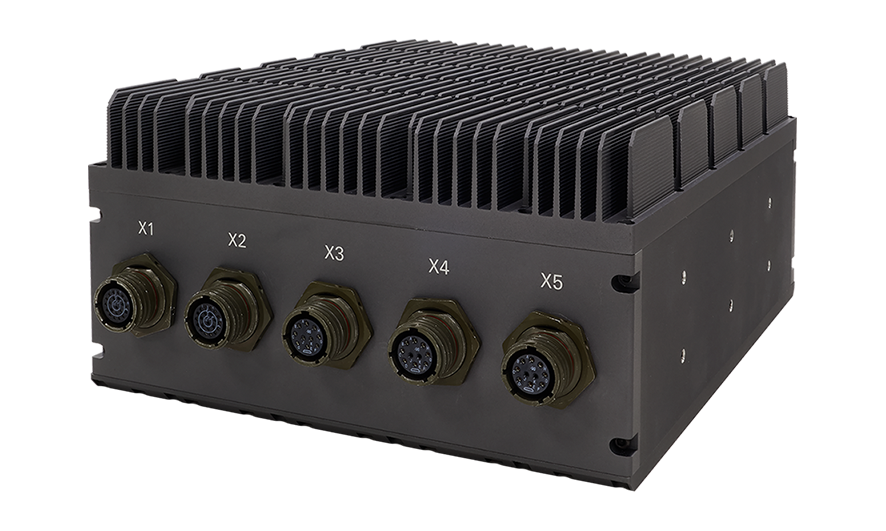Technical Profile
Introduction
AV710 is driven by Intel 6th generation Skylake-H i7-6822EQ Processor soldering onboard which is an extremely compact Core I-based fanless rugged system. Skylake-H processor supports outstanding CPU and graphics performance, providing 4 cores 2.8GHz clock speed while consuming low power consumption 25W. AV710 highlight on its rugged design and high functionality, the system especially installed MIL-STD Amphenol type connector and full IP65 protection allow system withstand in any kind of harsh environment. AV710 supports extended temperature from -40°C to 70°C and wide range 9V~36V DC input (optional MIL-STD-1275/704/461 Power supply) can protect system from damages caused by sudden surge of voltage, thus further secure the reliability of its critical components and the system itself.

System main board: SK513

1. Customized demands for different applications
AV710 is based on SK513, powered by either Intel® 6th Gen Core™ i7-6820EQ or i7 Intel® 7th Gen Core™ i7-7820EQ and chipset soldering onboard. SK513 can be customized with upgradeable CPU,GPU in order to have more flexibility and be more user-friendly. SK513 is designed to fulfill demands of different applications, such as defense, marine navigation and aviation technology.
2. Rugged expansion slot brings high reliability
With stackable PCIe 104 expansion slot, SK513 brings many advantages, including fast data transfer, low cost and high reliability due to PCIe 104’s inherent ruggedness, and long-term sustainability. The rugged modules are optimized for mission-critical, harsh environments where failure caused by sudden shock or unpredictable vibration is not an option.

NVIDIA GPU, Extraordinary Graphic Performance

AV710 is installed with NVIDIA GTX1050Ti GPU 768 CUDA Cores, GDDR 4GB/NVIDIA 1050Ti CUDA 765 GDDR5-4GB/GTX 1650 CUDA896 GDDR5-4GB/GTX 1660S CUDA1408 GDDR6-6GB GPU that generates excellent resolution and supports high efficiency and fluency of image processing with competitive G3D Mark and low power consumption. Inherited the remarkable ruggedness and dual-sided thermal design of AV710 can efficiently dissipate the heat generated from both CPU and GPU, maintaining the stability of solution performance. The system possess great superiority for image computing utilization, including 2D/3D mapping and real-time image process for autonomous vehicle, surveillance system for command center, other navigation, radar, detection, sensor and laser systems on all maritime, ground, and aerial applications in both defense and industrial fields.
CPU Full Speed over Wide Range Temperature
Intel 6th generation Skylake-H series processors are primarily targeted towards ultimate mobile performance, mobile workstations, and performance embedded devices. Featuring 64-bit dual-core SoC , Skylake-H series processors improve cost, power consumption, and heat dissipation, which are desirable for embedded systems. Thus, equipped with Intel® Skylake-H i7-6822EQ , AV710 provides leading performance while cosuming lower power. In addition,7STARLAKE’s patented thermal dissipation design ensures CPU to run at full speed under extended temperature ranging from -40 to 70°C.
Patented Thermal Solution
7STARLAKE designs a unique enclosure that is able to stack together both horizontally and vertically. The aluminum heat sink enclosure of AV710 secures top heat dissipation. It’s well-known that fanless method relies heavily on the precise calculation of the efficiency of each heat dissipating component.7STARLAKE exclusively adopts special heat radiating material and combining with special CNC cutting, further forged into a lavish sophisticated metal. Superior fanless design guarantees silent operation that enhances the flexibility of mobility and prevents the intrusion of dust and debris. Achieving ultimate reliability and stability, AV710 can operate under extended temperature ranging from -40 to 70°C.
Full IP65 Anti-water / dust protection
AV710 has complete resistance to dust and water, making it even more ruggedized and reliable. With the water and dust protection up to IP65 rating, AV710 can stand against the intrusion of dust, accidental contact, and water. Not just commercial grade waterproof and dustproof, it can reach Dust Tight level, which guarantees complete protection against ingression. Even the strong power of water jet won’t pose a threat to it, , which means it’s true ruggedness embodied.
MIL-STD -461
MIL-STD-461 is a military standard that establishes the control of electromagnetic interference (EMI) emissions and susceptibility characteristics of electronic, electrical & electromechanical equipment and subsystems for military equipment. EMI encompasses any undesired signals, “noise”, generated by electronic equipment. Keeping EMI under control is crucial for military applications, because if it’s out of control, the military will be detected by the enemy and it might cause a great loss. To design a product that meets strict requirements, engineers should possess extensive knowledge of both electrical and mechanical design to avoid unintentional generation, propagation and reception of electromagnetic energy, which may cause unwanted effects, for example, physical damage in operational equipment.

Block diagram of MIL-STD-461 test configuration
Rugged D38999 Series connectors
MIL-DTL-38999 is a high-performance cylindrical connector family designed to withstand the extreme shock, exposure and vibration that are commonplace in Defense and aerospace applications. D38999 connectors are lightweight and can stand up to environmental challenges. Made with removable crimp or fixed hermetic solder contacts, these connectors provide high-vibration characteristics and are suitable for severe wind and moisture problem areas. Equipped with MIL-38999 4/10/22 pin connectors TV07RW-11-54P, TV07RW-13-98S, and TV07RW-13-35S, AV710 is undoubtedly durable and ruggedized enough despite operating in the harsh environment.
Supporting NVIDIA GTX 1050 Ti/1650/1660S
Powered by NVIDIA, CUDA® is a parallel computing platform and programming model developed by NVIDIA for general computing on graphical processing units (GPUs). With CUDA, developers are able to dramatically speed up computing applications by harnessing the power of GPUs. In GPU-accelerated applications, the sequential part of the workload runs on the CPU – which is optimized for single-threaded performance – while the compute intensive portion of the application runs on thousands of GPU cores in parallel.








